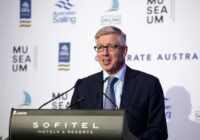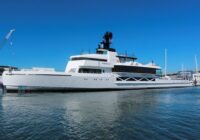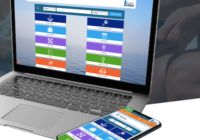A partnership that has produced the perfect harmony.
Since its inception, Maritimo has always been at the very forefront of integrating innovative design and technology into the manufacturing of its world class, ocean going, luxury motor yachts.
Critical to the success of each model range, and each vessel, is the craft of selecting the right power plant size, output, and ultimately, brand. In business, and in sport, it is often said that ‘you can’t lead by following.’ Maritimo’s move into offering the choice of Scania, away from the more traditionally known USA built power plants at the time, some did say was a bold move…
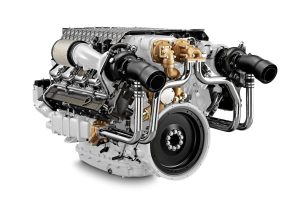
Perhaps, for not only were the Maritimos of that era being built and delivered to Australian buyers, the company was also cracking into the North American market at that time, and the potential risk was that the Americans may not take to kindly to an ‘up and comer from down under’ with power provided by a European engine manufacturer.
A recent chat with Scania’s Andre Arm – National Manager, and Jason Rendle – Account Manager for QLD/NT & NSW, shed a little light on the early days of the Maritimo-Scania relationship, as well as a few insights into ‘where to from here’.
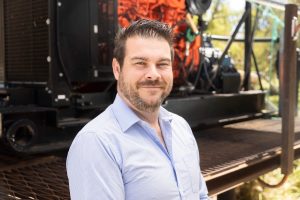
“I’ve been at Scania 26 years now,’ Arm opened with. “Jason joined us just over three years ago. He has a long history with Bill Barry-Cotter, through one of Bill’s previous ventures,” he added.
“Originally, Bill contacted Scania around the beginning of his journey with Maritimo. He’d had a good experience with Scania on a boat that he had been involved with for the America’s Cup. He was interested in the product, and he was looking at new and better options for more power and better fuel economy. So, my manager at the time, Rob Taylor and I suited up, jumped on a plane, came to Brisbane and drove down to the Gold Coast and met with Bill.”
“Everything stacked up well, except at that time unfortunately the pleasure craft range of engines from Scania was sold through a partnership with another manufacturer. So, we didn’t have the full control of those engines. Bill was quite adamant that he was only going to talk to engine manufacturers with direct representation in Australia – and no one else!
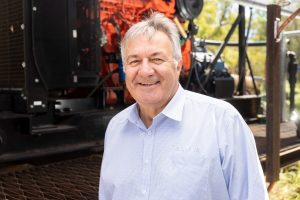
So, we sort of put the deal to the side at that time. But then a couple of years later, in 2010 or 11, things changed. We invited Bill and his wife Leslie to come to Sweden, because by then we had control directly in Australia of our engine offering and we were releasing a new range of engines, with more power. After the meeting in Sweden, which was a really fun time too, Scania was able to supply the first set of engines for Bill’s own boat. Bill wanted to go ahead with Scanias for his own boat and prove to everyone else within his company that it was going to be a good engine for the Maritimo production line. The engines were fitted to Bill’s C60, his new single level design at the time – it had a very elegant, and a very European flavour to it,” Arm said.
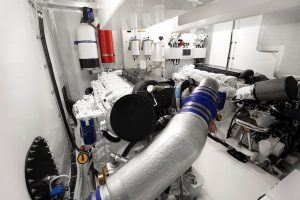
“Ross Willaton was doing the sea trials on that first boat and he found that he had about 25% of the engine load left over, once he propped it up. He called us and said, ‘What load can I get on those engines?’ So, we said, well, you can go to the maximum load. He had re-propped everything and was really, obviously interested in getting the optimum speed, but also efficiencies on that boat, which Rossco’s has always been really good at. He was especially interested because the Scanias had a different range of torque and power to other manufacturers at that stage. He’s been a very good advocate for the product since, and we’ve got a really good relationship with him, as well as the whole team.”
“It was a very important moment for everybody, because most of the engines sold previously were American engines, and I can say from that time we’ve always had a very fair and friendly relationship. I remember one day I was sitting with Bill and I said, ‘Bill, you need to tell me honestly what’s going on because, you know, you’ve got people buying boats from two and a half, to three million upwards and you’re telling me fuel consumption is important to them?’ And he said, ‘Well, first of all, they’re not millionaires for no reason. And then secondly, fuel consumption is important, not just for the price of the fuel, but also for the range of the boat. You know the capacity to go up to Hamilton Island from the Gold Coast, with one stop, instead of three.’ Maritimos are now renowned for their long-range capabilities, and Bill clearly had his eye on achieving this,” Arm added.
“From those early days, and on to today, local flexibility is what we would say is key to delivering on what’s being asked for. Our dealers here are actually adding a lot of options to our engines as we receive them from the factory. When I look at what advantage Scania has over our competition, we provide an extremely refined diesel power plant, with strong efficiency and simplicity. It’s a very popular choice, not just because of the V8 design, which Aussies love, and especially the Americans too, but because of the power and the range it offers.”
“And another of the more important points that our customers will like with things like our new e-machine is the fact that Scania controls most of the components on the boat – the inverters, electric pumps etc. A lot of our competition at the moment is picking up different components from different manufacturers and trying to get them all together. We’re delivering a complete system and supporting it from the Scania perspective,” Arm said.
“With gearboxes it’s a three-way relationship and it’s dictated completely by what Maritimo want and order. So, it’s ZF, it’s Twin Disc, and its Scania. Depending on what the customer is looking for, we will supply either box in any way, shape or form. There is no bias either way from our perspective,” Arm added.
“For the future of course, Scania is looking at multiple solutions now to meet environmental, legislative, and our customers’ needs,” Rendle said.
“So yes, biodiesel and depending on the engine, we can go up to 100% biodiesel,” he added. “We’re already running that on many work boats which deliver less power output than what’s required for Maritimo.”
“We’re also pushing very hard with Scania’s e-machine, which we’re going to be able to put in between the engine and the gearbox. We’ve got a trial boat working in Sweden fitted with two e-machines and three batteries and this boat can do eight knots for six hours, without the engine running. This e-machine is also a booster when you’re underway, so if you’ve got battery power, 1150 horsepower twin engine on a 20-meter boat, and the three batteries, they were getting about 54 knots.”
“With the combined power you can use the engine to recharge your battery because it is also a generator, when you want it to be such. So, it can be a motor on its own if you disconnect it from the engine, you just put it into a mode that the engine has no relation with it, or you can have it as a booster on the top of the diesel engine. In the future, and when we can get enough battery charging power, we’ll be able to have the e-machine on their own, without the diesel engine. And that e-machine is capable at the moment of 250 kilowatts continuous. And in the future, it will increase to, I think, 350 or 400 kilowatts,” Rendle continued.
“Scania has built our own lithium battery plant, which is a massive facility. We currently run our batteries in the truck and the bus world. So, by the time it is offered to the marine market, just like with all our other products, it is a fully proven and commercially operated product. Accordingly, Scania doesn’t go through an adjustment period when we release these products. The products are already tried and tested in the real world. And in the marine world, we enjoy these benefits.”
“The hurdles of the past are what helps us through the problems of the future,” Rendle added in closing.





